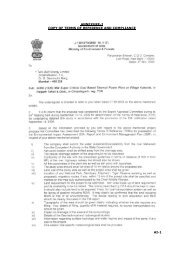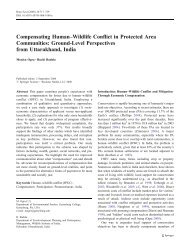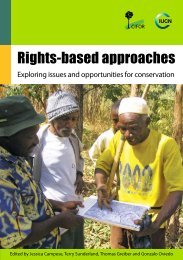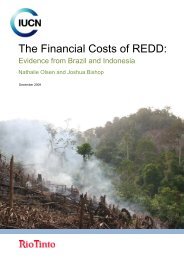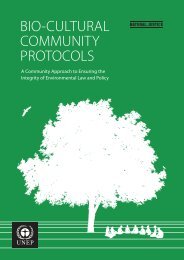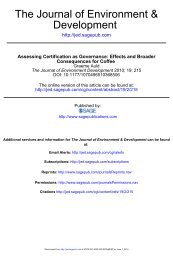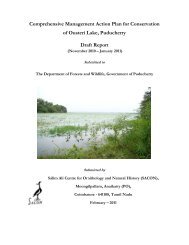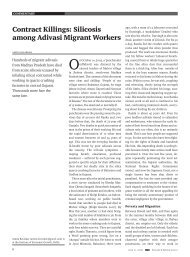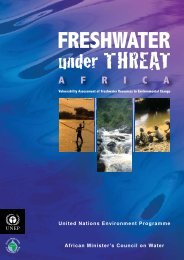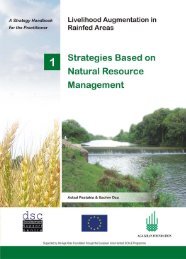Integrated River Basin Planning – Replicable ... - India Water Portal
Integrated River Basin Planning – Replicable ... - India Water Portal
Integrated River Basin Planning – Replicable ... - India Water Portal
Create successful ePaper yourself
Turn your PDF publications into a flip-book with our unique Google optimized e-Paper software.
<strong>Integrated</strong> <strong>River</strong> <strong>Basin</strong> <strong>Planning</strong>: <strong>India</strong> and the EU share experience on policy and practice<br />
IWRM Principles and <strong>Planning</strong> Processes<br />
Figure 2<br />
Cross sectoral water resource management<br />
Figure 3<br />
The three IWRM pillars<br />
Cross sectoral water resource management<br />
1 Enabling<br />
Environment<br />
Economic Equity Environmental<br />
2 Institutional<br />
Framework<br />
<strong>Water</strong> for People <strong>Water</strong> for food <strong>Water</strong> for nature<br />
<strong>Water</strong> for industry and<br />
other use<br />
3 Management<br />
Tools<br />
Management<br />
Instruments<br />
Assessment<br />
Information<br />
Allocation<br />
instruments<br />
Enabling<br />
Environment<br />
Policies<br />
Legislation<br />
Institutional<br />
Framework<br />
Central<strong>–</strong>Local<br />
<strong>River</strong> <strong>Basin</strong><br />
Public<strong>–</strong>Private<br />
the environment and thus as an important step on the road towards integrating<br />
water into overall sustainable socio-economic development.<br />
IWRM is the “integrating handle” leading from sub-sectoral towards cross-sectoral<br />
water resources management and at the same time providing a framework for<br />
provision of water services.<br />
The following definition by GWP has proven to be a useful definition of IWRM<br />
widely supported in an international context:<br />
IWRM is a process which promotes the coordinated development and management<br />
of water, land and related resources, in order to maximize the resultant economic<br />
and social welfare in an equitable manner without compromising the sustainability<br />
of vital ecosystems.<br />
An important aspect of IWRM is to enhance cross-sectoral water resources<br />
management in order to replace what is considered to be inefficient sub-sectoral<br />
management within the different individual water use sectors.<br />
IWRM is not a goal in itself. The specific goals, interests and challenges will vary<br />
from place to place depending on the specific ecological, social and economic<br />
situation. IWRM is the process of balancing and making trade-offs, in a practical,<br />
scientifically sound way, between economic efficiency in water use; social justice<br />
and equity concerns; and environmental and ecological sustainability. The specific<br />
details of these goals will have to be balanced in the IWRM process. Implementing<br />
IWRM is a political process that involves allocating resources between competing<br />
uses and users. Sometimes, it is possible to come up with win-win solutions.<br />
However, more often, compromises and trade-offs have to be negotiated.<br />
Agreeing to social, economic and ecosystem sustainability goals and finding the<br />
right balance between them lie at the heart of this process.<br />
As illustrated in Figure 3, concurrent development and strengthening of three<br />
elements is needed in order to pursue IWRM: an enabling environment, an<br />
appropriate institutional framework, and practical management instruments.<br />
Balance “water for livelihood” and “water as a resource”<br />
The enabling environment sets the rules; the institutional roles and functions<br />
define the players who make use of the management instruments.<br />
IWRM must not be interpreted as a universal blueprint for water resources<br />
management worldwide. Certain basic principles underlying IWRM may be<br />
commonly applicable, but they must be seen in the specific context and stage<br />
of economic or social development. The nature, character and severity of water<br />
problems, human resources, institutional capacities, and the relative strengths<br />
and characteristics of the public and private sectors, the cultural setting, natural<br />
conditions, and many other factors differ greatly between countries and regions.<br />
Practical implementation must reflect such variations in local conditions and<br />
should, consequently, take a variety of forms. The most appropriate mix of IWRM<br />
elements will change over time for a specific country and region due to internal or<br />
external developments.<br />
IWRM involves managing water resources at the basin or watershed scale,<br />
managing demand and optimizing supply including assessments of available<br />
surface and groundwater supplies and evaluating the environmental impacts of<br />
distribution and use options. IWRM principles are based on equitable access to<br />
water resources, broad stakeholder participation, an inter-sectoral approach to<br />
decision making based on sound science, and usually require establishment of<br />
adequate regulatory and institutional frameworks. The planning process should<br />
result in an IWRM plan endorsed and implemented by the government, more or<br />
less detailed depending on the situation and needs of the country.<br />
The institutional arrangements needed to bring IWRM into effect include:<br />
• water resources management based on hydrological boundaries;<br />
• a gender-balanced consortium of decision-makers representing all<br />
12 13



